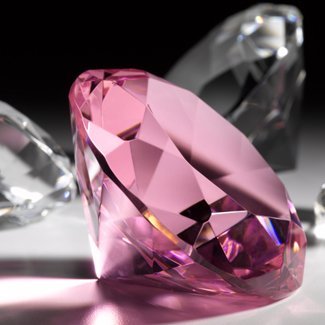Uncovering the mystery of pink diamonds

ARGYLE DIAMONDS, FROMWestern Australia, are the most valuable diamonds on the market, but their natural pink colour is still a mystery to scientists.
However, new research into the photochromic behaviour of Argyle diamonds – or the way in which the diamonds change colour upon exposure to light – may have brought scientists one step closer to uncovering the truth.
Led by Keal Byrne, a PhD student at the University of Western Australia in Perth, the researchers used a suite of lights with narrow frequencies to bleach the colour from the pink diamonds, in order to understand their photochromic behaviour.
“We are attempting to understand this process better – what light removes the colour, what light brings it back, and what this all means for the diamond’s structure,” says Keal.
“[We] hope that this may be one step towards finally determining what it is that creates the pink colouration in Argyle diamond.”
Why diamonds have colour
Diamonds are made from carbon atoms bonded together in a crystalline lattice that doesn’t absorb light, which results in the colourless appearance characteristic of a pure diamond.
Coloured diamonds, such as Argyle diamonds, have what is known as a defect centre, where one or more of the carbon atoms in the diamond lattice may be missing, or may have been replaced with a different element.
With enough of these defect centres the diamond may take on different properties, such as absorbing light to the point of a visible colour difference.
“Different defects produce different colours,” says Keal. “Sufficient nitrogen atoms in a diamond will make a diamond appear yellow; enough boron impurities can make a diamond appear blue.”
The defect centres that cause the pink colour in diamonds remain unknown.
Pink diamonds useful in scientific research
The study, which was published recently in the journal Diamond and Related Materials, will contribute significantly to future research, according to Dr Eloise Gaillou from the Natural History Museum of Los Angeles, in California, USA.
“This paper provides new constraints on the colour centre responsible for the most valuable gems available on the market: natural pink diamonds,” says Eloise.
“The pink (to purple, to red) colour in natural diamonds is still an enigma for scientists, whereas nowadays most other causes of colour in diamonds can be explained.”
Eloise added that Argyle diamonds were the best samples to use for the study, because the highly intense pink colouring means that any changes in colour can be easily observed.
Keal believes that the pink diamonds, and other unexplored diamond defects, may also be useful for emerging technologies.
“Light-sensitive diamond defects are finding more and more uses in scientific research, from biomedical imaging to quantum computers,” says Keal.
“The more we learn, the more likely we are to find something that may one day contribute to these technologies.”

